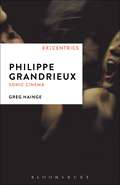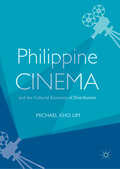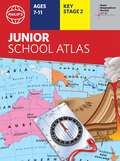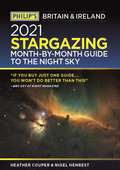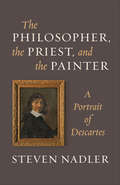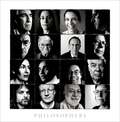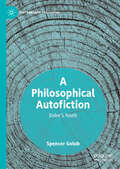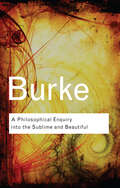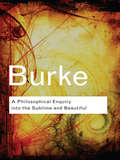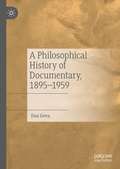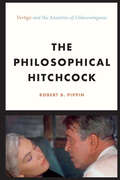- Table View
- List View
Philippe Grandrieux: Sonic Cinema (EX:CENTRICS)
by Greg HaingePhilippe Grandrieux is one of cinema's only living true radicals and feted as one of the most innovative and important film makers of his generation. His consistently controversial work remains, however, relatively unknown outside of the international art film festival circuit. In this volume, the first book-length study of the work of Grandrieux in any language, Greg Hainge provides an overview and critical analysis of Grandrieux's entire career during which he has produced works for television, video installations, photography, performance pieces, documentary films, short films and prize-winning feature films. As well as providing an overview, the book argues that a critical appraisal of his work necessarily leads us to problematize many of the critical orthodoxies that have been formed in recent times, to reject the concept of a haptic cinema and to supplant this instead with the idea of a sonic cinema.
Philippine Cinema and the Cultural Economy of Distribution
by Michael Kho LimThis book explores the complex interplay of culture and economics in the context of Philippine cinema. It delves into the tension, interaction, and shifting movements between mainstream and independent filmmaking, examines the film distribution and exhibition systems, and investigates how existing business practices affect the sustainability of the independent sector. This book addresses the lack or absence of Asian representation in film distribution literature by supplying the much-needed Asian context and case study. It also advances the discourse of film distribution economy by expounding on the formal and semi-formal film distribution practices in a developing Asian country like the Philippines, where the thriving piracy culture is considered as ‘normal,’ and which is commonly depicted and discussed in existing literature. As such, this will be the first book that looks into the specifics of the Philippine film distribution and exhibition system and provides a historical grounding of its practices.
Philip's 2022 Stargazing Month-by-Month Guide to the Night Sky in Britain & Ireland (Philip's Stargazing)
by Nigel Henbest Heather Couper"If you buy just one guide...you won't do better than this" BBC Sky at Night Magazine"I will continue to enjoy 'Philip's Stargazing' as the months go by" Helen Sharman, Astronaut "Very useful indeed" Chris Lintott, Sky at Night presenterDiscover the latest in stargazing with the new and definitive guide to the night sky.Whether you're a seasoned astronomer or just starting out, Philip's Stargazing 2022 is the only book you'll need. Compiled by experts and specially designed for use in Britain and Ireland, Stargazing 2022 acts as a handily illustrated and comprehensive companion.- 12 Brand-New Maps for year-round astronomical discovery- Month-to-Month information. Daily Moon Phase Calendar, highlighting special lunar events throughout the year- Planet Watch for ideal viewing days in 2022- Avoid light pollution with our detailed Dark Sky Map- Expert advice and insight throughout from internationally renowned Professor Nigel Henbest- A 'Behind the Scenes' look at astrophotography from expert Robin Scagell- Complete calendar of major astronomical events, including the Top 20 Sky Sights of 2022- Jargon Buster, explaining common or confusing terms - The planets' movements explained from solar and lunar eclipses to meteor showers and comets
Philip's RGS Junior School Atlas (Philip's World Atlas #28)
by Philip's MapsThe 11th edition of the market-leading atlas for primary school pupils, Philip's RGS Junior School Atlas has been fully revised and updated with all the latest facts and curriculum requirements. - The essential atlas for primary schools with clear and easy-to-follow maps and diagrams - updated for 2021/22- Published in association with the Royal Geographical Society- Recommended for Key Stage 2 of the National Curriculum - and all 7-11 year olds - An excellent introduction to mapping concepts such as scale, direction, symbols, longitude and latitude- 22-page Britain and Ireland section with clear thematic charts, diagrams and large-scale regional maps- 22-page section on The World, with political maps - and thematic treatment of key themes, from volcanoes and earthquakes to transport and tourism- Continents section with physical and political maps- Easy-to-follow map references and 1,000-place indexThe market-leading atlas for pupils at primary schools, Philip's RGS Junior School Atlas is a stimulating and authoritative first introduction to the world of maps, and is recommended for Key Stage 2 of the National Curriculum.The introductory section describes the meaning of scale, how to measure distances using the maps, and explains the symbols on the maps.The following section is devoted to the United Kingdom and Ireland. Thematic maps cover topics such as mountains and rivers, climate and weather, population and cities, farming and fishing, industry and energy, transport, tourism and conservation. Regional maps of England and Wales, Scotland and Ireland complete this section.The rest of the atlas is made up of world thematic maps and world continental maps. Included are topics such as the world's climate, vegetation, agriculture, energy sources, and environmental concerns, such as global warming. A simple letter-figure index completes the atlas - a useful introduction to help the young reader find his/her way around the maps. Available in both hardback and paperback editions.
Philip's RGS Junior School Atlas (Philip's World Atlas #28)
by Philip's MapsThe 12th edition of the market-leading atlas for primary school pupils, Philip's RGS Junior School Atlas has been fully revised and updated with all the latest facts and curriculum requirements.- The essential atlas for primary schools with clear and easy-to-follow maps and diagrams - updated for 2024/2025- Published in association with the Royal Geographical Society- Recommended for Key Stage 2 of the National Curriculum - and all 7-11 year olds - An excellent introduction to mapping concepts such as scale, direction, symbols, longitude and latitude- 22-page Britain and Ireland section with clear thematic charts, diagrams and large-scale regional maps- 22-page section on The World, with political maps - and thematic treatment of key themes, from volcanoes and earthquakes to transport and tourism- Continents section with physical and political maps- Easy-to-follow map references and 1,000-place indexThe introductory section describes the meaning of scale, how to measure distances using the maps, and explains the symbols on the maps.The following section is devoted to the United Kingdom and Ireland. Thematic maps cover topics such as mountains and rivers, climate and weather, population and cities, farming and fishing, industry and energy, transport, tourism and conservation. The rest of the atlas is made up of world thematic maps and world continental maps. Included are topics such as the world's climate, vegetation, agriculture, energy sources, and environmental concerns, such as global warming. A simple letter-figure index completes the atlas. Available in both Hardback and Paperback editions.
Philip's Stargazing 2024 Month-by-Month Guide to the Night Sky Britain & Ireland (Philip's Stargazing)
by Nigel Henbest"If you buy just one guide...you won't do better than this." - BBC Sky at Night Magazine"I will continue to enjoy 'Philip's Stargazing' as the months go by." - Helen Sharman, Astronaut"Very useful indeed." - Chris Lintott, Sky at Night presenterNow including the top astronomical places to visit, star festivals and the latest on star parties in Britain and Ireland, the new 2024 edition is totally up-to-date for exploring the wonder of the night skies, month-by-month and day-by-day.Whether you're a seasoned astronomer or just starting out, Philip's Stargazing 2024 is the only book you'll need. Compiled by experts and specially designed for easy and daily use, Stargazing 2024 acts as a handily illustrated and comprehensive companion.- 12 updated sky charts for year-round astronomical discovery- Month-to-Month information. Daily Moon Phase Calendar, highlighting special lunar events throughout the year- Planet Watch for ideal viewing days in 2024- The best places to experience Dark Skies, along with the latest on Star Festivals and Star Parties- Top places to visit for astronomical insights- Expert advice and insight throughout from internationally renowned Prof Nigel Henbest- Special article on the use of filters for astro-photography by expert Robin Scagell- Complete calendar of major astronomical events, including the Top 20 Sky Sights of 2024- Jargon Buster, explaining common or confusing terms- The planets' movements explained from solar and lunar eclipses to meteor showers and comets
Philip's Stargazing 2025 Month-by-Month Guide to the Night Sky Britain & Ireland (Philip's Stargazing)
by Nigel HenbestPhilip's Stargazing is the perfect practical guide for both budding and experienced astronomers."If you buy just one guide...you won't do better than this." - BBC Sky at Night Magazine"I will continue to enjoy 'Philip's Stargazing' as the months go by." - Helen Sharman, Astronaut"Very useful indeed." - Chris Lintott, Sky at Night presenterPhilip's Stargazing is essential for all those who enjoy exploring the night sky, with up-to-date monthly star charts, moon calendars and viewing tips, as well as the best dark-sky sites to visit and astronomy festivals through the year. Compiled by experts and specially designed for easy use, Stargazing 2025 is a comprehensive companion for both seasoned and novice astronomers.* Fully updated colour star chart for each month of the year* Viewing recommendations and practical advice* Top constellation, target object, topic and picture for each month* Daily Moon Phase Calendar, highlighting special lunar events throughout the year * Planet Watch for ideal viewing days in 2025 * The best places to experience Dark Skies * The latest on Star Festival, Star Parties and astronomy-themed days out* Expert advice from internationally renowned astronomer professor Nigel Henbest * Special article by equipment expert Robin Scagell on small refracting telescopes* Complete calendar of major astronomical events * Top 20 Sky Sights of 2025 * Jargon Buster, explaining common or confusing terms * Clear explanation of the planets' movements, solar and lunar eclipses, meteors and comets
Philip's Stargazing Month-by-Month Guide to the Night Sky Britain & Ireland (Philip's Stargazing)
by Heather Couper Nigel Henbest"IF YOU BUY JUST ONE GUIDE... YOU WON'T DO BETTER THAN THIS" BBC Sky at Night Magazine"I WILL CONTINUE TO ENJOY 'STARGAZING' AS THE MONTHS GO BY" Helen Sharman, Astronaut "VERY USEFUL INDEED" Chris Lintott, Sky at Night presenterDiscover the latest in star gazing with the new and definitive guide to the night sky.Whether you're a seasoned astronomer or just starting out, Philip's Stargazing 2021 is the only book you'll need. Compiled by experts and specially designed for use in Britain and Ireland, Stargazing 2021 acts as a handily illustrated and comprehensive companion.- 12 Brand-New Maps for year-round astronomical discovery- Month-to-Month informationDaily Moon Phase Calendar, highlighting special lunar events throughout the year- Planet Watch for ideal viewing days in 2021- Avoid light pollution with our detailed Dark Sky Map- Expert advice and insight throughout from internationally renowned Professors Couper and Henbest- Using Binoculars - Stargazing recommendations from expert Robin Scagell- Perfect for home use during lockdown- Complete calendar of major astronomical events, including the Top 20 Sky Sights of 2021- Jargon Buster, explaining common or confusing terms - The planets' movements explained from solar and lunar eclipses to meteor showers and comets
Philip's Stargazing Month-by-Month Guide to the Night Sky Britain & Ireland (Philip's Stargazing)
by Nigel Henbest"If you buy just one guide...you won't do better than this" BBC Sky at Night Magazine"I will continue to enjoy 'Philip's Stargazing' as the months go by" Helen Sharman, Astronaut"Very useful indeed" Chris Lintott, Sky at Night presenterNow including the top astronomical places to visit, star festivals and the latest on star parties in Britain and Ireland, the new 2023 edition is totally up-to-date for exploring the wonder of the night skies, month-by-month and day-by-day. Whether you're a seasoned astronomer or just starting out, Philip's Stargazing 2023 is the only book you'll need. Compiled by experts and specially designed for easy and daily use, Stargazing 2023 acts as a handily illustrated and comprehensive companion.- 12 updated sky charts for year-round astronomical discovery- Month-to-Month information. Daily Moon Phase Calendar, highlighting special lunar events throughout the year- Planet Watch for ideal viewing days in 2023- The best places to experience Dark Skies, along with the latest on Star Festivals and Star Parties- Top places to visit for astronomical insights- Expert advice and insight throughout from internationally renowned Prof Nigel Henbest- The latest on electronic telescopes from expert Robin Scagell- Complete calendar of major astronomical events, including the Top 20 Sky Sights of 2023- Jargon Buster, explaining common or confusing terms - The planets' movements explained from solar and lunar eclipses to meteor showers and comets
Philip's Stargazing Month-by-Month Guide to the Night Sky Britain & Ireland
by Nigel Henbest Heather Couper"IF YOU BUY JUST ONE GUIDE... YOU WON'T DO BETTER THAN THIS" BBC Sky at Night Magazine · 12 month-by-month Night Sky Maps for year-round stargazing · Monthly Calendar of moon phases and special events in 2019 · Planet Watch: the best viewing days for planets in 2019 · Dark Sky Map of the UK - find the darkest skies · Optical Equipment Guide - Which Telescope? · The major astronomical events of 2019· Month-by-month top 20 Sky Sights 2019 Plus: · Expert advice on what to see each month from Heather Couper and Nigel Henbest, Philip's internationally renowned authors. · The Solar System 2019 explains the movement of the planets, with particular attention paid to their positions in 2019. Solar and lunar eclipses, meteor showers and comets are also described. · Expert Robin Scagell's Equipment Review looks at the pros and cons of Stargazing with reflector or refractor telescopes. · And all superbly illustrated with photographs taken by the best amateur photographers illustrating the night skies. Book Description Philip's Month-by-Month Stargazing 2019 is the guide for Stargazers in Britain and Ireland. The new 2019 edition has been completely revised to make it even more essential for exploring the night skies. Essential reading for astronomers at all levels - and the perfect gift for every stargazer. About the Authors Philip's Stargazing Month by Month 2019 is written by two of the UK's best-known and respected astronomers. Professor Heather Couper CBE, FRAS, is an internationally acclaimed astronomer, writer and presenter/producer of TV and radio programmes. Professor Nigel Henbest researched in radio astronomy at Cambridge University, with the Astronomer Royal, and has been a Consultant to both New Scientist magazine and the Royal Greenwich Observatory.
Philip's Stargazing Month-by-Month Guide to the Night Sky Britain & Ireland (Philip's Stargazing)
by Nigel Henbest Heather Couper"IF YOU BUY JUST ONE GUIDE... YOU WON'T DO BETTER THAN THIS" BBC Sky at Night Magazine · 12 month-by-month Night Sky Maps for year-round stargazing · Monthly Calendar of moon phases and special events in 2020 · Planet Watch: the best viewing days for planets in 2020 · Dark Sky Map of the UK - find the darkest skies · How to photograph the night skies - with cameras and smartphones · The major astronomical events of 2020 · Month-by-month Top 20 Sky Sights 2020· Plus new, illustrated Jargon Buster Plus: · Expert advice on what to see each month from Heather Couper and Nigel Henbest, Philip's internationally renowned authors. · The Solar System 2020 explains the movement of the planets, with particular attention paid to their positions in 2020. Solar and lunar eclipses, meteor showers and comets are also described. · Expert Robin Scagell's Equipment Review looks at the pros and cons of Stargazing with reflector or refractor telescopes. · And all superbly illustrated with photographs taken by the best amateur photographers illustrating the night skies.About the Authors Philip's Stargazing Month by Month 2020 is written by two of the UK's best-known and respected astronomers.Prof. Heather Couper and Prof. Nigel Henbest are qualified astrophysicists, dedicated to sharing their love of the cosmos to everyone. They work in TV and radio broadcasting, international presentations, and have written over fifty popular books between them.
A Philosopher Looks At Architecture: (pdf) (A\philosopher Looks At Ser.)
by Paul GuyerWhat should our buildings look like? Or is their usability more important than their appearance? Paul Guyer argues that the fundamental goals of architecture first identified by the Roman architect Marcus Pollio Vitruvius - good construction, functionality, and aesthetic appeal - have remained valid despite constant changes in human activities, building materials and technologies, as well as in artistic styles and cultures. Guyer discusses philosophers and architects throughout history, including Alberti, Kant, Ruskin, Wright, and Loos, and surveys the ways in which their ideas are brought to life in buildings across the world. He also considers the works and words of contemporary architects including Annabelle Selldorf, Herzog and de Meuron, and Steven Holl, and shows that - despite changing times and fashions - good architecture continues to be something worth striving for. This new series offers short and personal perspectives by expert thinkers on topics that we all encounter in our everyday lives.
The Philosopher, the Priest, and the Painter: A Portrait of Descartes
by Steven NadlerIn the Louvre museum hangs a portrait that is considered the iconic image of René Descartes, the great seventeenth-century French philosopher. And the painter of the work? The Dutch master Frans Hals--or so it was long believed, until the work was downgraded to a copy of an original. But where is the authentic version, and who painted it? Is the man in the painting--and in its original--really Descartes? A unique combination of philosophy, biography, and art history, The Philosopher, the Priest, and the Painter investigates the remarkable individuals and circumstances behind a small portrait. Through this image--and the intersecting lives of a brilliant philosopher, a Catholic priest, and a gifted painter--Steven Nadler opens a fascinating portal into Descartes's life and times, skillfully presenting an accessible introduction to Descartes's philosophical and scientific ideas, and an illuminating tour of the volatile political and religious environment of the Dutch Golden Age. As Nadler shows, Descartes's innovative ideas about the world, about human nature and knowledge, and about philosophy itself, stirred great controversy. Philosophical and theological critics vigorously opposed his views, and civil and ecclesiastic authorities condemned his writings. Nevertheless, Descartes's thought came to dominate the philosophical world of the period, and can rightly be called the philosophy of the seventeenth century. Shedding light on a well-known image, The Philosopher, the Priest, and the Painter offers an engaging exploration of a celebrated philosopher's world and work.
The Philosopher, the Priest, and the Painter: A Portrait of Descartes
by Steven NadlerIn the Louvre museum hangs a portrait that is considered the iconic image of René Descartes, the great seventeenth-century French philosopher. And the painter of the work? The Dutch master Frans Hals--or so it was long believed, until the work was downgraded to a copy of an original. But where is the authentic version, and who painted it? Is the man in the painting--and in its original--really Descartes? A unique combination of philosophy, biography, and art history, The Philosopher, the Priest, and the Painter investigates the remarkable individuals and circumstances behind a small portrait. Through this image--and the intersecting lives of a brilliant philosopher, a Catholic priest, and a gifted painter--Steven Nadler opens a fascinating portal into Descartes's life and times, skillfully presenting an accessible introduction to Descartes's philosophical and scientific ideas, and an illuminating tour of the volatile political and religious environment of the Dutch Golden Age. As Nadler shows, Descartes's innovative ideas about the world, about human nature and knowledge, and about philosophy itself, stirred great controversy. Philosophical and theological critics vigorously opposed his views, and civil and ecclesiastic authorities condemned his writings. Nevertheless, Descartes's thought came to dominate the philosophical world of the period, and can rightly be called the philosophy of the seventeenth century. Shedding light on a well-known image, The Philosopher, the Priest, and the Painter offers an engaging exploration of a celebrated philosopher's world and work.
Philosophers
by Steve PykeSteve Pyke, a photographer whose work is a regular feature of The New Yorker and Vanity Fair, is known for his stunning portraits of prominent authors, artists, actors, and intellectuals. In this riveting collection, which he has been working on for twenty-five years, Pyke presents 100 black-and-white portraits of contemporary philosophers, photographed in his distinctive style. The effect of his technique can be startling but always revealing, showing insight into personality while shedding new light on the philosophical temperament. These fascinating portraits feature virtually every major philosopher working in the West, including Anthony Appiah, David Chalmers, Umberto Eco, Ruth Marcus, Richard Rorty, Roger Scruton, and Peter Singer, among others. The facing page of each portrait contains a brief piece written by the subject on the nature of philosophy and their place in it. For this volume, Arthur C. Danto has written a foreword and Jason Stanley has interviewed Pyke. Both a who's who of philosophy today and a stunning gallery of captivating images, this marvelous volume is the long-awaited sequel to Pyke's original collection, published in 1993.
Philosophers
by Steve PykeSteve Pyke, a photographer whose work is a regular feature of The New Yorker and Vanity Fair, is known for his stunning portraits of prominent authors, artists, actors, and intellectuals. In this riveting collection, which he has been working on for twenty-five years, Pyke presents 100 black-and-white portraits of contemporary philosophers, photographed in his distinctive style. The effect of his technique can be startling but always revealing, showing insight into personality while shedding new light on the philosophical temperament. These fascinating portraits feature virtually every major philosopher working in the West, including Anthony Appiah, David Chalmers, Umberto Eco, Ruth Marcus, Richard Rorty, Roger Scruton, and Peter Singer, among others. The facing page of each portrait contains a brief piece written by the subject on the nature of philosophy and their place in it. For this volume, Arthur C. Danto has written a foreword and Jason Stanley has interviewed Pyke. Both a who's who of philosophy today and a stunning gallery of captivating images, this marvelous volume is the long-awaited sequel to Pyke's original collection, published in 1993.
A Philosophical Autofiction: Dolor's Youth (Performance Philosophy)
by Spencer GolubThis is a book about what becomes of the truth when it succumbs to generational memory loss and to the fictions that intervene to cause and fill the gaps. It is a book about the impossibility of writing an autobiography when there is a prepossessing cultural and familial 'we' interfering with the 'I' and an 'I' that does not know itself as a self, except metastatically — as people and characters it has played but not actually been.A highly original combination of close readings and performative autobiography, this book takes performance philosophy to an alternative next step, by having its ideas read back to it by experience, and through assorted fictions. It is a philosophical thought experiment in uncertainty whose literary, theatrical, and cinematic trappings illustrate and finally become what this uncertainty is, the thought experiment having become the life that was, that came before, and that outlives the 'I am'.
Philosophical Difference and Advanced Computation in Architectural Theory: From Less to More
by Jefferson EllingerThis book presents a new take on the evolution of digital design theories in architecture from modernity to today, as they have been inspired both by contemporary philosophy and the emergence and access to advanced computation. It focuses on how concepts of difference in philosophy transformed architectural design theory and takes on even more significance with the introduction and ubiquitous use of computers within the discipline, changing the architectural design paradigm forever. Beginning with a presentation of American Pragmatism’s push towards process, the book continues on to Husserl’s influence on the modern movement, mid-century phenomenology, post-structuralist Derridean exchanges with architects, the Deleuzian influence on the smoothing of form and finally contemporary architectural references to speculative realism. Analyzing the arc of design theory as influenced by philosophical and computational logics, this book presents the transformation to contemporary design approaches that includes more biology, more data and more information, moving from "less is more" to "From Less to More!" Philosophical Difference and Advanced Computation in Architectural Theory is an influential read for students and academics of architectural theory, computational design and related areas.
Philosophical Difference and Advanced Computation in Architectural Theory: From Less to More
by Jefferson EllingerThis book presents a new take on the evolution of digital design theories in architecture from modernity to today, as they have been inspired both by contemporary philosophy and the emergence and access to advanced computation. It focuses on how concepts of difference in philosophy transformed architectural design theory and takes on even more significance with the introduction and ubiquitous use of computers within the discipline, changing the architectural design paradigm forever. Beginning with a presentation of American Pragmatism’s push towards process, the book continues on to Husserl’s influence on the modern movement, mid-century phenomenology, post-structuralist Derridean exchanges with architects, the Deleuzian influence on the smoothing of form and finally contemporary architectural references to speculative realism. Analyzing the arc of design theory as influenced by philosophical and computational logics, this book presents the transformation to contemporary design approaches that includes more biology, more data and more information, moving from "less is more" to "From Less to More!" Philosophical Difference and Advanced Computation in Architectural Theory is an influential read for students and academics of architectural theory, computational design and related areas.
A Philosophical Enquiry Into the Sublime and Beautiful
by Edmund BurkeEdited with an introduction and notes by James T. Boulton. 'One of the greatest essays ever written on art.'– The Guardian Edmund Burke’s A Philosophical Enquiry into the Origin of our Ideas of the Sublime and Beautiful is one of the most important works of aesthetics ever published. Whilst many writers have taken up their pen to write of "the beautiful", Burke’s subject here was the quality he uniquely distinguished as "the sublime"—an all-consuming force beyond beauty that compelled terror as much as rapture in all who beheld it. It was an analysis that would go on to inspire some of the leading thinkers of the age, including Immanuel Kant and Denis Diderot. The Routledge Classics edition presents the authoritative text of the first critical edition of Burke’s essay ever published, including a substantial critical and historical commentary. Edmund Burke (1729–1797). A politician, philosopher and orator, Burke lived during a turbulent time in world history, which saw revolutions in America and France that inspired his most famous work, Reflections on the Revolution in France.
A Philosophical Enquiry Into the Sublime and Beautiful
by Edmund BurkeEdited with an introduction and notes by James T. Boulton. 'One of the greatest essays ever written on art.'– The Guardian Edmund Burke’s A Philosophical Enquiry into the Origin of our Ideas of the Sublime and Beautiful is one of the most important works of aesthetics ever published. Whilst many writers have taken up their pen to write of "the beautiful", Burke’s subject here was the quality he uniquely distinguished as "the sublime"—an all-consuming force beyond beauty that compelled terror as much as rapture in all who beheld it. It was an analysis that would go on to inspire some of the leading thinkers of the age, including Immanuel Kant and Denis Diderot. The Routledge Classics edition presents the authoritative text of the first critical edition of Burke’s essay ever published, including a substantial critical and historical commentary. Edmund Burke (1729–1797). A politician, philosopher and orator, Burke lived during a turbulent time in world history, which saw revolutions in America and France that inspired his most famous work, Reflections on the Revolution in France.
A Philosophical History of Documentary, 1895–1959
by Dan GevaThis book presents a chronology of thirty definitions attributed to the word, term, phrase, and concept of “documentary” between the years 1895 and 1959. The book dedicates one chapter to each of the thirty definitions, scrutinizing their idiosyncratic language games from close range while focusing on their historical roots and concealed philosophical sources of inspiration. Dan Geva's principal argument is twofold: first, that each definition is an original ethical premise of documentary; and second, that only the structured assemblage of the entire set of definitions successfully depicts the true ethical nature of documentary insofar as we agree to consider its philosophical history as a reflective object of thought in a perpetual state of being-self-defined: an ethics sui generis.
The Philosophical Hitchcock: “Vertigo” and the Anxieties of Unknowingness
by Robert B. PippinOn the surface, The Philosophical Hitchcock: Vertigo and the Anxieties of Unknowingness, is a close reading of Alfred Hitchcock’s 1958 masterpiece Vertigo. This, however, is a book by Robert B. Pippin, one of our most penetrating and creative philosophers, and so it is also much more. Even as he provides detailed readings of each scene in the film, and its story of obsession and fantasy, Pippin reflects more broadly on the modern world depicted in Hitchcock’s films. Hitchcock’s characters, Pippin shows us, repeatedly face problems and dangers rooted in our general failure to understand others—or even ourselves—very well, or to make effective use of what little we do understand. Vertigo, with its impersonations, deceptions, and fantasies, embodies a general, common struggle for mutual understanding in the late modern social world of ever more complex dependencies. By treating this problem through a filmed fictional narrative, rather than discursively, Pippin argues, Hitchcock is able to help us see the systematic and deep mutual misunderstanding and self-deceit that we are subject to when we try to establish the knowledge necessary for love, trust, and commitment, and what it might be to live in such a state of unknowingness. A bold, brilliant exploration of one of the most admired works of cinema, The Philosophical Hitchcock will lead philosophers and cinephiles alike to a new appreciation of Vertigo and its meanings.
Philosophical Logic: A Contemporary Introduction (ISSN)
by John MacFarlaneIntroductory logic is generally taught as a straightforward technical discipline. In this book, John MacFarlane helps the reader think about the limitations of, presuppositions of, and alternatives to classical first-order predicate logic, making this an ideal introduction to philosophical logic for any student who already has completed an introductory logic course.The book explores the following questions. Are there quantificational idioms that cannot be expressed with the familiar universal and existential quantifiers? How can logic be extended to capture modal notions like necessity and obligation? Does the material conditional adequately capture the meaning of 'if'—and if not, what are the alternatives? Should logical consequence be understood in terms of models or in terms of proofs? Can one intelligibly question the validity of basic logical principles like Modus Ponens or Double Negation Elimination? Is the fact that classical logic validates the inference from a contradiction to anything a flaw, and if so, how can logic be modified to repair it? How, exactly, is logic related to reasoning? Must classical logic be revised in order to be applied to vague language, and if so how? Each chapter is organized around suggested readings and includes exercises designed to deepen the reader's understanding.Key Features: An integrated treatment of the technical and philosophical issues comprising philosophical logic Designed to serve students taking only one course in logic beyond the introductory level Provides tools and concepts necessary to understand work in many areas of analytic philosophy Includes exercises, suggested readings, and suggestions for further exploration in each chapter
Philosophical Logic: A Contemporary Introduction (ISSN)
by John MacFarlaneIntroductory logic is generally taught as a straightforward technical discipline. In this book, John MacFarlane helps the reader think about the limitations of, presuppositions of, and alternatives to classical first-order predicate logic, making this an ideal introduction to philosophical logic for any student who already has completed an introductory logic course.The book explores the following questions. Are there quantificational idioms that cannot be expressed with the familiar universal and existential quantifiers? How can logic be extended to capture modal notions like necessity and obligation? Does the material conditional adequately capture the meaning of 'if'—and if not, what are the alternatives? Should logical consequence be understood in terms of models or in terms of proofs? Can one intelligibly question the validity of basic logical principles like Modus Ponens or Double Negation Elimination? Is the fact that classical logic validates the inference from a contradiction to anything a flaw, and if so, how can logic be modified to repair it? How, exactly, is logic related to reasoning? Must classical logic be revised in order to be applied to vague language, and if so how? Each chapter is organized around suggested readings and includes exercises designed to deepen the reader's understanding.Key Features: An integrated treatment of the technical and philosophical issues comprising philosophical logic Designed to serve students taking only one course in logic beyond the introductory level Provides tools and concepts necessary to understand work in many areas of analytic philosophy Includes exercises, suggested readings, and suggestions for further exploration in each chapter
